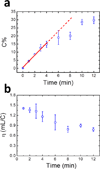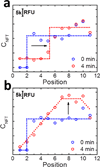Low-voltage paper isotachophoresis device for DNA focusing
- PMID: 26338530
- PMCID: PMC4589534
- DOI: 10.1039/c5lc00875a
Low-voltage paper isotachophoresis device for DNA focusing
Abstract
We present a new paper-based isotachophoresis (ITP) device design for focusing DNA samples having lengths ranging from 23 to at least 1517 bp. DNA is concentrated by more than two orders of magnitude within 4 min. The key component of this device is a 2 mm-long, 2 mm-wide circular paper channel formed by concertina folding a paper strip and aligning the circular paper zones on each layer. Due to the short channel length, a high electric field of ~16 kV m(-1) is easily generated in the paper channel using two 9 V batteries. The multilayer architecture also enables convenient reclamation and analysis of the sample after ITP focusing by simply opening the origami paper and cutting out the desired layers. We profiled the electric field in the origami paper channel during ITP experiments using a nonfocusing fluorescent tracer. The result showed that focusing relied on formation and subsequent movement of a sharp electric field boundary between the leading and trailing electrolyte.
Figures






Similar articles
-
Amplification-free detection of DNA in a paper-based microfluidic device using electroosmotically balanced isotachophoresis.Lab Chip. 2018 Mar 13;18(6):861-868. doi: 10.1039/c7lc01250k. Lab Chip. 2018. PMID: 29459920
-
On-chip isotachophoresis for separation of ions and purification of nucleic acids.J Vis Exp. 2012 Mar 2;(61):e3890. doi: 10.3791/3890. J Vis Exp. 2012. PMID: 22415002 Free PMC article.
-
Low-voltage origami-paper-based electrophoretic device for rapid protein separation.Anal Chem. 2014 Dec 16;86(24):12390-7. doi: 10.1021/ac503976c. Epub 2014 Dec 2. Anal Chem. 2014. PMID: 25456275
-
Microfluidic isotachophoresis: a review.Electrophoresis. 2013 Jun;34(11):1493-509. doi: 10.1002/elps.201300021. Epub 2013 May 14. Electrophoresis. 2013. PMID: 23529957 Review.
-
Purification of nucleic acids using isotachophoresis.J Chromatogr A. 2014 Mar 28;1335:105-20. doi: 10.1016/j.chroma.2013.12.027. Epub 2013 Dec 15. J Chromatogr A. 2014. PMID: 24444800 Review.
Cited by
-
Recent Advances in Microfluidic Paper-Based Analytical Devices toward High-Throughput Screening.Molecules. 2020 Jun 28;25(13):2970. doi: 10.3390/molecules25132970. Molecules. 2020. PMID: 32605281 Free PMC article. Review.
-
Nucleic acid sample preparation from whole blood in a paper microfluidic device using isotachophoresis.J Chromatogr B Analyt Technol Biomed Life Sci. 2021 Jan 15;1163:122494. doi: 10.1016/j.jchromb.2020.122494. Epub 2020 Dec 13. J Chromatogr B Analyt Technol Biomed Life Sci. 2021. PMID: 33401049 Free PMC article.
-
HIV detection from human serum with paper-based isotachophoretic RNA extraction and reverse transcription recombinase polymerase amplification.Analyst. 2021 May 4;146(9):2851-2861. doi: 10.1039/d0an02483j. Analyst. 2021. PMID: 33949378 Free PMC article.
-
Towards Multiplex Molecular Diagnosis-A Review of Microfluidic Genomics Technologies.Micromachines (Basel). 2017 Aug 30;8(9):266. doi: 10.3390/mi8090266. Micromachines (Basel). 2017. PMID: 30400456 Free PMC article. Review.
-
Recent Advances of Fluid Manipulation Technologies in Microfluidic Paper-Based Analytical Devices (μPADs) toward Multi-Step Assays.Micromachines (Basel). 2020 Mar 4;11(3):269. doi: 10.3390/mi11030269. Micromachines (Basel). 2020. PMID: 32143468 Free PMC article. Review.
References
-
- Jung B, Bharadwaj R, Santiago JG. On-chip millionfold sample stacking using transient isotachophoresis. Anal. Chem. 2006;78:2319–2327. - PubMed
-
- Liu H, Crooks RM. Three-Dimensional Paper Microfluidic Devices Assembled Using the Principles of Origami. J. Am. Chem. Soc. 2011;133:17564–17566. - PubMed
-
- Luo L, Li X, Crooks RM. Low-Voltage Origami-Paper-Based Electrophoretic Device for Rapid Protein Separation. Anal. Chem. 2014;86:12390–12397. - PubMed
-
- Carrilho E, Martinez AW, Whitesides GM. Understanding Wax Printing: A Simple Micropatterning Process for Paper-Based Microfluidics. Anal. Chem. 2009;81:7091–7095. - PubMed
Publication types
MeSH terms
Substances
Grants and funding
LinkOut - more resources
Full Text Sources
Other Literature Sources

